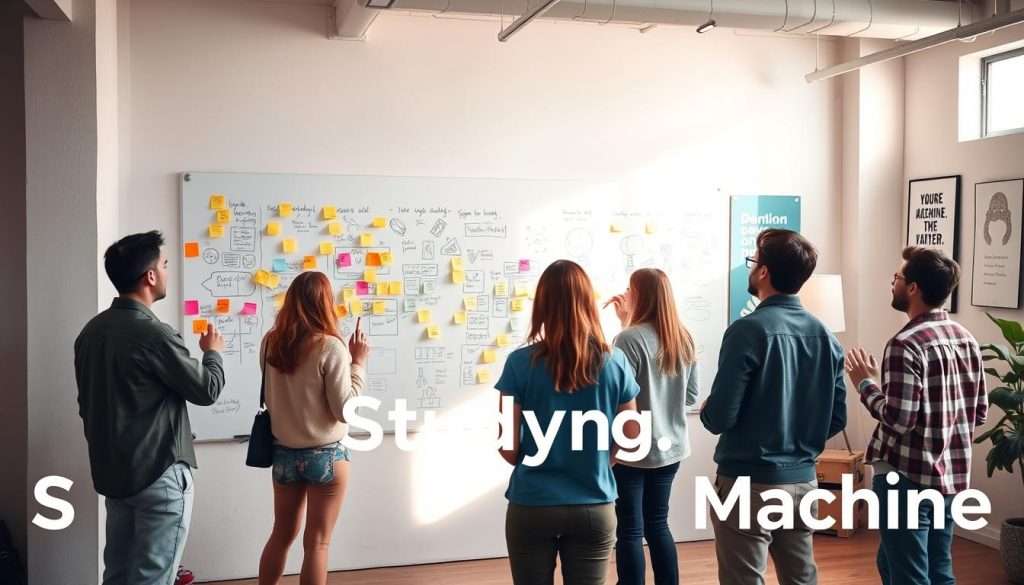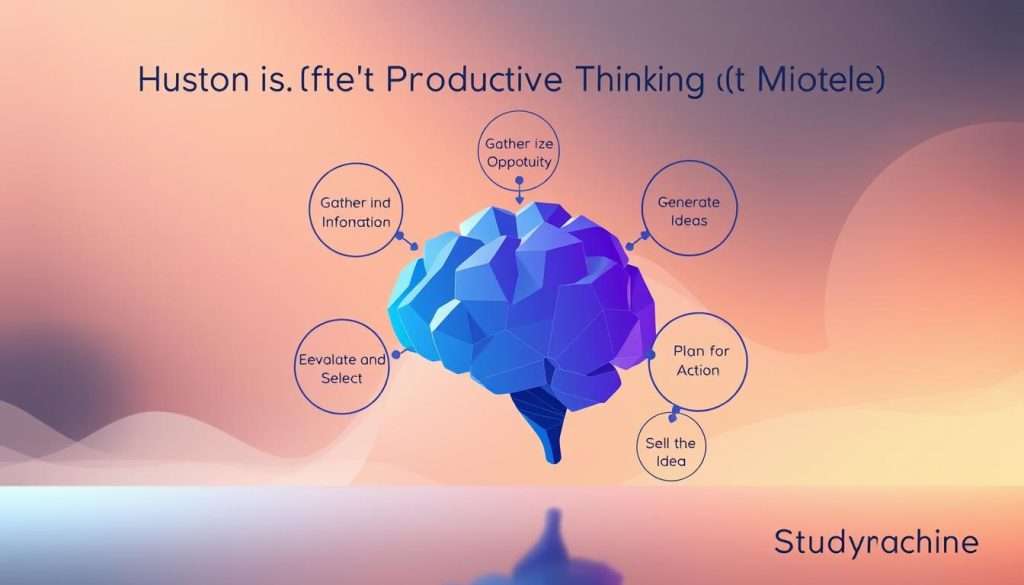Welcome to the world of productive thinking! We’re excited to share a game-changing framework with you. It will change how you tackle problems. In today’s fast world, thinking well is key.
This innovative thinking framework helps you come up with more ideas and judge them well. By the end of this article, you’ll know the productive thinking approach inside out. You’ll be ready to use it in your life.
Key Takeaways
- Understand the six-step process of Hurson’s Productive Thinking Model
- Learn how to generate more options and evaluate them effectively
- Discover how to apply productive thinking to your daily life
- Develop your critical thinking skills with a structured approach
- Improve your problem-solving abilities with creative thinking
The Challenge of Effective Problem-Solving
Complex problems need more than just usual thinking; they ask for a structured yet creative approach. We’ve all been stuck in a problem, unsure of how to go on. Traditional ways of thinking can be too narrow, as they stick to familiar patterns.
Why Traditional Thinking Methods Fall Short
Traditional thinking methods often fail because they don’t promote out-of-the-box thinking or structured creativity. For example, when we face a tough issue, we might turn to old solutions that don’t work. This leads to frustration and getting stuck.
By not questioning our beliefs, we miss chances for new ideas. This is where the critical thinking process helps. It’s about looking at facts clearly and making smart choices. Yet, even critical thinking can get better with a more structured problem-solving method.
The Need for Structured Creative Thinking
The need for a balanced approach to solving problems is clear. By mixing creative problem solving with a step-by-step method, we can handle complex issues better. This means breaking down problems, questioning our beliefs, and coming up with many possible solutions.
By using this method, we can go beyond usual thinking and find new solutions. It’s about being careful with our problem-solving method and using the power of structured creativity.
Understanding Huron’s Productive Thinking Model
Imagine a way to tackle your biggest challenges with a mix of structure and innovation. Tim Hurson’s Productive Thinking Model is that approach. It’s the result of years of research and practice in solving complex problems creatively.
Origins and Development of the Framework
Tim Hurson’s deep experience in creativity and innovation led to this model. He created a framework that helps users solve problems in a logical yet creative way. It shows that everyone can think productively with the right tools and techniques.
The need for a structured method in creative problem-solving influenced Hurson’s model. Old methods often lack a clear path to new solutions. Hurson’s model offers a systematic process that boosts both creativity and critical thinking.
The Six-Step Process Overview
The model has a six-step process to move from understanding a problem to finding a solution. The steps are: “What’s Going On?”, “What’s Success?”, “What’s the Question?”, “Generate Answers”, “Forge the Solution”, and “Align Resources”. Each step builds on the last, ensuring a thorough and innovative problem-solving approach.
By using these steps, people and teams can better understand their problems and find innovative solutions. Hurson’s Productive Thinking Model is a valuable tool for improving problem-solving skills.
Step1: What’s Going On? – Exploring the Situation
Before we start solving problems, let’s take a closer look at the situation. It’s important to understand the context and gather all the necessary information. This helps us solve problems more effectively.
Techniques for Comprehensive Situation Analysis
To really get to the bottom of things, we can use a few techniques. SWOT analysis helps us find the strengths, weaknesses, opportunities, and threats. The 5 Whys technique is another great tool. It asks “why” five times to find the root cause.
Stakeholder analysis also gives us valuable insights. It shows us what different people affected by the problem need and want. This helps us understand the situation better.
Practical Tools for Information Gathering
Gathering information is key to understanding the situation. Here are some useful tools:
- Mind maps: These visual tools help organize and connect ideas.
- Surveys and questionnaires: They’re great for getting data from many people.
- Interviews: Talking in-depth with important people gives us detailed insights.
Exercise: Mapping Your Current Reality
Now, let’s try these techniques out. Spend a few minutes making a mind map or simple diagram of your situation. Include the main elements, stakeholders, and any obstacles. This exercise will help you see the situation clearly and get ready for the next steps.
Step2: What’s Success? – Defining Your Vision
Let’s focus on creating a clear vision of success. This is a key step in the productive thinking approach. It sets the stage for the critical thinking process that follows.
Methods for Creating Clear Success Criteria
To define success, we need clear criteria. This means identifying what makes our solution successful. Some effective methods include:
- Setting specific, measurable goals
- Identifying key performance indicators (KPIs)
- Establishing a clear timeline for achieving success
These methods help us create a strong framework for evaluating success. This framework guides our decisions in the critical thinking process.
Visualization Techniques for Desired Outcomes
Visualization is a powerful tool for imagining our desired outcomes. Techniques like mind mapping, vision boards, and guided imagery can help. For example, you can start a mind map with a central idea and branch out to related concepts.
Example: Let’s say you’ve set success criteria for a project. You can make a vision board with images and words that represent your goals. Arrange them in a way that inspires you.
Exercise: Crafting Your Success Statements
Now, it’s your turn to write your success statements. Take a few minutes to describe what success looks like for your project or challenge. Use these prompts to guide you:
- What specific outcomes do you want to achieve?
- How will you measure the success of your solution?
- What are the key elements that will make your solution successful?
By writing clear success statements, you’ll guide your critical thinking. This ensures your solutions align with your goals.
Step3: What’s the Question? – Framing the Problem
How we frame a problem can greatly affect our ability to solve it. It’s an art to ask the right question to find new ways to tackle it. We’ll dive into the science of framing problems well and share tips to craft strong problem statements.
The Science of Effective Problem Formulation
Formulating a problem well is more than just stating it. It’s about grasping the underlying issues and constraints. Studies show framing a problem correctly boosts our creativity in solving it. A well-crafted problem statement can lead us to innovative solutions. To do this, we must:
- Identify the key elements of the problem
- Understand the root causes, not just symptoms
- Look at it from different angles to gain a broader view
Reframing Techniques to Unlock New Perspectives
Reframing means seeing a problem from various viewpoints to uncover new insights. Some effective ways to do this include:
- Asking “why” several times to find the real cause
- Turning the problem statement around to see it differently
- Using analogies to connect the problem to something familiar
These methods can turn a tough problem into a solvable challenge.
Exercise: Creating Powerful Problem Statements
Now, it’s your turn to try reframing a problem. Pick a challenge you’re facing and:
- Write down how you see the problem now
- Use reframing techniques to come up with new problem statements
- Choose the statement that seems most promising
By reframing, you’ll open up new paths for solving problems creatively.
Step4: Generate Answers – Mastering Creative Ideation
In this step, we’ll explore the power of divergent thinking. It’s the ability to come up with many ideas or solutions. This skill is key for solving problems creatively.
Proven Divergent Thinking Techniques
To get better at creative thinking, use techniques that spark your brain. Some effective brainstorming techniques include:
- Mind mapping: A visual way to explore ideas and their connections.
- SCAMPER: An acronym for Substitute, Combine, Adapt, Modify, Put to Another Use, Eliminate, and Rearrange. It helps make new ideas from old ones.
- Free writing: Write down your thoughts without stopping or worrying about grammar or spelling.

Strategies for Overcoming Creative Blocks
Even creative minds hit blocks sometimes. Try changing your environment, taking a break, or finding inspiration elsewhere. Collaborating with others can also spark new ideas.
Exercise: Structured Brainstorming Methods
Now, let’s practice these techniques with a structured brainstorming session. Follow these steps:
| Step | Description | Time |
|---|---|---|
| 1 | Define the problem | 5 minutes |
| 2 | Generate ideas individually | 10 minutes |
| 3 | Share and discuss ideas | 15 minutes |
By mastering these creative problem-solving techniques, you’ll develop an innovative thinking framework. This framework can tackle many challenges.
Step5: Forge the Solution – Evaluating and Strengthening Ideas
We’ve got our ideas now. It’s time to make a solid plan by using convergent thinking and decision-making strategies. This step turns our creative ideas into real solutions.
Convergent Thinking Tools for Idea Selection
Convergent thinking tools help us pick the best solutions. Methods like dot voting and Paired Comparison Analysis help teams choose ideas that work well. These tools make sure our ideas are not just new but also useful and meet our goals.
The Pros and Cons Analysis is another great way to decide. It looks at each idea’s good points and bad points. This method helps us make smart choices by showing the ups and downs of each option.
Decision-Making Frameworks for Optimal Solutions
Decision-making frameworks give us a clear way to choose the best solution. The DECIDE model is one example. It helps teams go through a step-by-step process to pick the right solution.
The Multi-Criteria Decision Analysis (MCDA) is also helpful. It looks at options based on many factors. This is great when we have to think about lots of things when making a choice.
Exercise: Solution Refinement Process
To make your solution better, do these steps:
- List all the ideas from brainstorming.
- Use dot voting to pick the top three ideas.
- Do a Pros and Cons Analysis for each top idea.
- Apply the DECIDE model to choose the final solution.
By using this process, you’ll make your ideas stronger and more practical. This leads to a solid solution.
Step6: Align Resources – Implementing Your Solution
The final step in Huron’s Productive Thinking Model is about aligning resources to implement your solution successfully. You’ve developed a great solution using the productive thinking approach; now let’s focus on making it happen.
Creating Effective Action Plans
To implement your solution, start by creating a detailed action plan. Break down the larger task into smaller, manageable steps. Identify the resources you’ll need, including time, money, and personnel. Use a project management tool to organize these steps and track progress.
Resource Allocation Strategies
Effective resource allocation is crucial for successful implementation. Assess your available resources and allocate them based on priority and need. Consider using the innovative thinking framework to find creative ways to utilize limited resources. Be flexible and prepared to adjust your allocation as circumstances change.
Overcoming Implementation Obstacles
Anticipate potential obstacles that might arise during implementation. Develop contingency plans for common issues, and be prepared to adapt your problem-solving method as needed. Stay focused on your goal, and don’t be afraid to seek help or advice from others when facing challenges.

By following these steps and staying committed to your plan, you can successfully implement your solution and achieve the desired outcomes. Remember, the key to successful implementation is careful planning, flexible resource allocation, and a proactive approach to overcoming obstacles.
Conclusion: Transforming Your Approach to Complex Problems
We’ve looked at Hurson’s Productive Thinking Model, a detailed way to tackle tough challenges. This six-step process boosts your creative problem-solving and critical thinking.
The model guides you through steps like exploring situations and defining success. It also helps you frame problems, generate answers, forge solutions, and align resources. With practice, you’ll get better at solving complex problems.
Try using Hurson’s Productive Thinking Model on your everyday challenges. Regular use will help you think more productively in all areas of life.
Adding this model to your problem-solving tools makes you ready for complex situations. Start using Hurson’s Productive Thinking Model today. See how your critical thinking skills improve.

